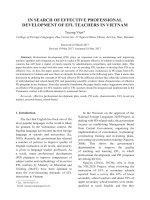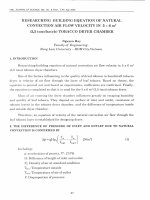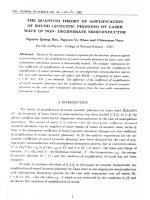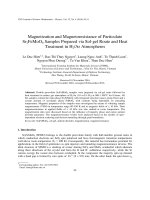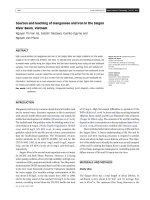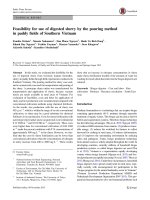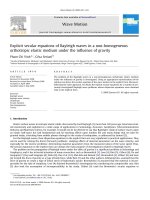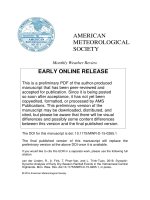DSpace at VNU: In Vitro Vasoactivity of Zerumbone from Zingiber zerumbet
Bạn đang xem bản rút gọn của tài liệu. Xem và tải ngay bản đầy đủ của tài liệu tại đây (198.99 KB, 8 trang )
Original Papers
In Vitro Vasoactivity of Zerumbone from
Zingiber zerumbet
Authors
Fabio Fusi 1, Miriam Durante 1, Giampietro Sgaragli 1, Pham Ngoc Khanh 2, Ninh The Son 2, Tran Thu Huong 2, Van Ngoc
Huong 3, Nguyen Manh Cuong 2
Affiliations
1
2
3
Key words
" Zingiber zerumbet
l
" Zingiberaceae
l
" zerumbone
l
" L‑type Ca2+ channel
l
" whole‑cell patch‑clamp
l
" vascular smooth muscle
l
received
revised
accepted
Nov. 11, 2014
Dec. 24, 2014
January 8, 2015
Bibliography
DOI />10.1055/s-0034-1396307
Published online February 25,
2015
Planta Med 2015; 81: 298–304
© Georg Thieme Verlag KG
Stuttgart · New York ·
ISSN 0032‑0943
Correspondence
Dr. Fabio Fusi
Università di Siena
Dipartimento di Scienze della
Vita
via A. Moro 2
53100 Siena
Italy
Phone: + 39 05 77 23 44 38
Fax: + 39 05 77 23 44 46
Correspondence
Assoc. Prof. Nguyen Manh
Cuong
Institute of Natural Products
Chemistry
Vietnam Academy of Science
and Technology
18 Hoang Quoc Viet Street
122100 Cau Giay, Hanoi
Vietnam
Phone: + 84 4 37 91 18 12
Fax: + 84 4 37 56 43 90
Fusi F et al. In Vitro Vasoactivity …
Dipartimento di Scienze della Vita, Università di Siena, Siena, Italy
Institute of Natural Products Chemistry, Vietnam Academy of Science and Technology, Hanoi, Vietnam
Faculty of Chemistry, VNU University of Science, Vietnam National University, Hanoi, Vietnam
Abstract
!
The sesquiterpene zerumbone, isolated from the
rhizome of Zingiber zerumbet Sm., besides its
widespread use as a food flavouring and appetiser, is also recommended in traditional medicine for the treatment of several ailments. It has
attracted great attention recently for its effective
chemopreventive and therapeutic effects observed in various models of cancer. To assess the
zerumbone safety profile, a pharmacology study
designed to flag any potential adverse effect on
vasculature was performed. Zerumbone was
tested for vasorelaxing activity on rat aorta rings
and for L-type Ba2+ current blocking activity on
single myocytes isolated from the rat-tail artery.
The spasmolytic effect of zerumbone was more
marked on rings stimulated with 60 mM than
Introduction
!
Plants, plant extracts, as well as plant-derived
products or “phytochemicals” have been used as
medicinal aids for millennia as they possess various and significant biological activities [1]. Thus,
traditionally, they are included in the diet of many
human societies (in particular the African and
Asian ones) owing to the common belief that they
are beneficial to health.
Zingiber zerumbet (L.) Smith (Zingiberaceae)
(Vietnamese name “Gung gio”) is an up to 1-m tall
ginger with pale flowers, fragrant rhizomes, and
spear-shape leaves, originating from Southeast
Asia. It grows in tropical countries including Malaysia, Laos, Thailand, and Vietnam, where it is
distributed mostly in midlands, low mountainous
regions, and even in plains [2, 3]. Despite its regular uses as a food flavouring and appetiser, the
rhizomes of Z. zerumbet are also used in traditional medicine as a cure for the treatment of inflammatory- and pain-associated (i.e., oedema, sprain,
Planta Med 2015; 81: 298–304
with 30 mM K+ (IC50 values of 16 µM and 102 µM,
respectively). In the presence of 60 mM K+, zerumbone concentration-dependently inhibited
the contraction induced by the cumulative additions of Ca2+, this inhibition being inversely related to the Ca2+ concentration. Phenylephrine-induced contraction was inhibited by the drug,
though less efficiently and independently of the
presence of an intact endothelium, without affecting Ca2+ release from the intracellular stores.
Zerumbone inhibited the L-type Ba2+ current (estimated IC50 value of 458.7 µM) and accelerated
the kinetics of current decay. In conclusion, zerumbone showed an overall weak in vitro vasodilating activity, partly attributable to the blocking
of the L-type Ca2+ channel, which does not seem
to represent, however, a serious threat to its
widespread use.
rheumatism), digestive system (i.e., constipation,
diarrhoea), and skin disease-related ailments [2,
4]. Various studies, based on a range of in vitro
and in vivo model systems, have shown the antiinflammatory, antinociceptive, antiulcer, antioxidant, anticancer, antimicrobial, antihyperglycemic, antiallergic, and antiplatelet aggregation activities of Z. zerumbet rhizome (reviewed in [2]).
For this reason, of all the parts of the plant, the
rhizome has been subjected to broad chemical investigations. The essential oil of Z. zerumbet rhizome consists mainly of sesquiterpenoids, of
which only zerumbone, [(2E,6E,10E)-2,6,9,9-tetramethylcycloundeca-2,6,10-trien-1-one]
" Fig. 1), the main constituent accounting for the
(l
55–85 % of the isolates [3], has been extensively
investigated. It has been shown to possess in vivo
antinociceptive, anti-inflammatory, and antitumour activities, while in vitro it has exhibited
antiproliferative and antiplatelet aggregation activities ([2] and references therein). More recently, Batubara et al. [5] showed that the inhala-
This document was downloaded for personal use only. Unauthorized distribution is strictly prohibited.
298
Original Papers
299
therefore desirable that the safety of these preparations and/or
their active principles is established through detailed studies. To
convince the regulatory committees that zerumbone is safe as
well as efficacious, it is necessary to determine its potential adverse effects on the cardiovascular system, as part of a Safety
Pharmacology “core battery” programme [11]. Therefore, the
aim of the present study was to assess the vascular activity of zerumbone, isolated and purified from Z. zerumbet rizhomes.
Results
Fig. 1 Spasmolytic effect of zerumbone on high K+-induced contraction
of rat aorta rings. a Rings were depolarised with either 30 or 60 mM extracellular K+. In the ordinate scale, the response is reported as a percentage of
the initial tension induced by 30 or 60 mM K+, taken as 100%. Data points
are mean ± SEM (n = 3–6). Inset: chemical structure of zerumbone isolated
from Z. zerumbet Smith. b Trace (representative of 3–6 similar experiments) of the relaxation developed in response to cumulative concentrations (µM) of zerumbone added at the plateau of 30 mM or 60 mM K+-elicited contraction. The effect of 100 µM sodium nitroprusside (SNP) is also
shown.
tion of zerumbone increases food consumption and body weight
gain in rats.
Zerumbone has attracted great attention recently for its potent
chemopreventive and therapeutic effects. In fact, it modulates
an array of important molecular targets (e.g., signal transduction
and apoptotic pathways) in tumour cells in vitro as well as in animal models of cancer (reviewed in [6]). The fact that zerumbone
is multi-target oriented is a very desirable property for cancer
therapy, as carcinomas at the various stages (i.e., initiation, progression, and metastasis) typically involve the dysregulation of
multiple genes and associated cell-signalling pathways [7]. Furthermore, owing to the causal relationship existing between inflammation and cancer, zerumbone is receiving increasing interest in anticancer drug development programs since it modulates
inflammation-related molecular targets [8, 9].
The lack of scientific and clinical data in support of the efficacy
and safety of phytochemicals represents the major encumbrance
to the acceptance of traditional herbal preparations by medical
doctors [10]. Moreover, the scarce or null recordings of adverse
reactions to herbal remedies (considered natural and, as such, erroneously safe) make their therapeutic use questionable. It is
Zerumbone (1) was isolated from the fresh rhizomes of Z. zerumbet crude extract by steam distillation. After recrystallisation
three times using absolute EtOH, zerumbone was isolated as
white needle crystals with 98% purity. Its molecular formula
was found to be C15H22O from the ESI‑MS pseudomolecular peak
at m/z 219.17 429 ([M + H]+) (calcd. for C15H23O 219.17 483). The
13
C‑NMR spectrum of compound 1 featured 15 carbon signals assignable to one carbonyl carbon (δC 204.3), three quaternary carbons (δC 137–38), four olefinic methine carbons (δC 160–124),
three methylene carbons, and four methyl carbons (δC 42–11).
On the basis of these spectroscopic data, compound 1 was identified as the previously reported zerumbone [12].
" Fig. 1 a, b, zerumbone caused a concentration-deAs shown in l
pendent relaxation of rings contracted by 60 mM K+ with an IC50
value of 16 ± 3.2 µM (n = 7). Under the same experimental conditions, the Ca2+ channel blocker nifedipine induced a concentration-dependent spasmolytic activity with an IC50 value of 8.0 ±
3.4 nM (n = 27). When the rings were depolarised with lower K+
concentrations (i.e., 30 mM), the spasmolytic potency of zerumbone decreased significantly and its IC50 value (102.0 ± 28.4 µM,
n = 6) was much greater than that recorded in rings depolarised
" Fig. 1 a, b). Zerumbone fully reverted
with 60 mM K+ (p < 0.01; l
" Fig. 1 a).
only the 60 mM K+-induced contraction (l
To test the hypothesis that zerumbone may compete with Ca2+
within the channel pore, the dependence of its inhibition on the
contraction induced by the addition of extracellular Ca2+ to high
K+-depolarized rings, in Ca2+-free physiological saline solution,
" Fig. 2 a shows the effects of the sesquiterpene
was examined. l
on the contraction induced by cumulative additions of Ca2+
(0.03–3 mM) to rings depolarised with 60 mM K+. Zerumbone reduced the Ca2+-induced contraction in a concentration-dependent manner (AUC values of 85.0 ± 7.1, n = 17, DMSO; 72.3 ± 18.3,
n = 12, 13.8 µM zerumbone; 41.7 ± 9.5, n = 11, 45.9 µM zerumbone, p < 0.05; 8.2 ± 2.2, n = 7, 137.6 µM zerumbone, p < 0.001); a
significant reduction in maximum response was also observed. It
is also evident that the inhibition exerted by 45.9 µM and
137.6 µM zerumbone, when calculated as a percentage of tension
recorded in the presence of DMSO, was inversely related to the
extracellular Ca2+ concentration (from 79.3 % and 96.1 % at
300 µM Ca2+ to 35.4 % and 78.1 % at 3 mM Ca2+, respectively).
Under the same experimental conditions, nifedipine induced a
concentration-dependent antispasmodic activity with an IC50
value of 27.1 ± 3.1 nM (n = 7).
At the end of the assay, after the last addition of Ca2+, any potential pharmacological interaction of zerumbone with (S)-(−)-Bay K
" Fig. 2 b). In rings pretreated with DMSO,
8644 was assessed (l
10 nM (S)-(−)-Bay K 8644 further stimulated vascular tone by
about 36%. At the highest concentration assessed, zerumbone also antagonised the stimulating effect of (S)-(−)-Bay K 8644.
Fusi F et al. In Vitro Vasoactivity …
Planta Med 2015; 81: 298–304
This document was downloaded for personal use only. Unauthorized distribution is strictly prohibited.
!
Original Papers
Fig. 2 Zerumbone inhibition of Ca2+-induced contraction of rat aorta
rings depolarised with high K+: effect of (S)-(−)-Bay K 8644. a Ca2+-induced
contraction in rings depolarised with a Ca2+-free, 60 mM K+ physiological
saline solution in the presence of DMSO or various concentrations of zerumbone. In the ordinate scale, the response is reported as a percentage of
the initial tension induced by 0.3 µM phenylephrine, taken as 100 %. Data
points are mean ± SEM (n = 7–17). * p < 0.05, *** p < 0.001 vs. DMSO.
b Effect of 10 nM (S)-(−)-Bay K 8644 on Ca2+-induced vascular tone of depolarised rings treated with zerumbone. Columns are mean ± SEM (n = 7–
16) and represent the percentage of the response to 60 mM K+, taken as
100 %. * p < 0.05, *** p < 0.001 vs. ‑Bay K 8644, Studentʼs t-test for paired
samples; ### p < 0.001 vs. DMSO, one-way ordinary ANOVA and Dunnettʼs
post-test.
The effects of zerumbone on L-type Ba2+ current [IBa(L)] recordings were assessed at a holding potential (Vh) of − 50 mV. Zerumbone decreased the current in a concentration-dependent man" Fig. 3 a) and, at the maxner (estimated IC50 value of 458.7 µM; l
imum concentration tested, significantly decreased the peak inward current in the range between − 20 mV and 50 mV without
changing the apparent maximum and the threshold of the cur" Fig. 3 b). Under the same experimenrent-voltage relationship (l
tal conditions, nifedipine induced a concentration-dependent inhibition of the current with an IC50 value of 19.1 ± 5.0 nM (n = 3).
Under control conditions, the current evoked at 10 mV from a Vh
of − 50 mV activated and then declined with a time course that
" Fig. 4 a). Zerumcould be fitted by a two-exponential function (l
bone accelerated the τ of inactivation in a concentration-depen" Fig. 4 b).
dent manner without affecting the τ of activation (l
" Fig. 5 a, zerumbone caused a concentration-deAs shown in l
pendent relaxation of endothelium-denuded rings contracted by
0.3 µM phenylephrine. Zerumbone, however, did not fully revert
the phenylephrine-induced contraction. Similar results were recorded on rings with an intact endothelium. Under the same ex-
Fusi F et al. In Vitro Vasoactivity …
Planta Med 2015; 81: 298–304
Fig. 3 Zerumbone inhibition of IBa(L) of single rat-tail artery myocytes.
a Concentration-dependent effect of zerumbone at the peak of IBa(L) trace.
On the ordinate scale, the response is reported as a percentage of the
control. Data points are mean ± SEM (n = 4–5). b Current-voltage relationships, recorded from a Vh of − 50 mV, constructed prior to the addition
(control) and in the presence of 458.7 µM zerumbone. Data points are
mean ± SEM (n = 5). * p < 0.05, ** p < 0.01 vs. control, Studentʼs t-test for
paired samples.
perimental conditions, the Ca2+ channel blocker verapamil induced a concentration-dependent spasmolytic activity with IC50
values of 813.3 ± 329.3 nM (endothelium denuded, n = 6) and
4.3 ± 1.7 µM (endothelium intact, n = 12), respectively.
Vasorelaxing agents can antagonise phenylephrine-promoted
contractions by inhibiting phenylephrine-induced Ca2+ release
from intracellular stores and/or extracellular Ca2+ influx. As
" Fig. 5 b, pretreatment with 137.6 µM zerumbone did
shown in l
not affect the contraction elicited by 10 µM phenylephrine in
Ca2+-free medium. When the normal external Ca2+ concentration
was restored, with phenylephrine still present, the sesquiterpene
significantly inhibited the ensuing contraction. Under the same
experimental conditions, the sarcoplasmic reticulum Ca2+ channel blocker ryanodine antagonised phenylephrine-induced Ca2+
release from intracellular stores (from 32.4 ± 3.5 % DMSO to
11.1 ± 1.8 %, ryanodine, n = 11; p < 0.001, Studentʼs t-test for
paired samples) leaving unaltered the extracellular Ca2+ influx
(from 74.4 ± 4.8% to 84.7 ± 1.9 %, n = 11; p > 0.05).
This document was downloaded for personal use only. Unauthorized distribution is strictly prohibited.
300
Fig. 4 Effects of zerumbone on IBa(L) current kinetics of single rat tail artery myocytes. a Traces of conventional whole-cell IBa(L) elicited with 250ms clamp pulses to 10 mV from a Vh of − 50 mV, measured in the absence
(control) or presence of various concentrations (µM) of zerumbone. Traces
recorded in the presence of zerumbone were magnified so that the peak
amplitude matched that of the control. b Time constant for the activation
(τact) and inactivation (τinact) measured in the absence (none) or presence
of different concentrations of zerumbone. Columns represent mean ± SEM
(n = 5). ** p < 0.01 and *** p < 0.001, repeated measures ANOVA and
Dunnettʼs post-test.
Fig. 5 Effect of zerumbone on the phenylephrine-induced contraction of
rat aorta rings. a Concentration-response curves for zerumbone in endothelium-denuded or ‑intact rings precontracted by 0.3 µM phenylephrine.
In the ordinate scale, relaxation is reported as the percentage of the initial
tension induced by phenylephrine, taken as 100%. Data points are mean ±
SEM (n = 4–6). b Columns represent 10 µM phenylephrine-induced contractions either in the absence (-Ca2+) or in the presence (+ Ca2+) of extracellular Ca2+, recorded in rings preincubated with vehicle (DMSO) or
137.6 µM zerumbone. Columns are mean ± SEM (n = 8) and represent the
percentage of the response to 0.3 µM phenylephrine, taken as 100 %.
* p < 0.05 vs. DMSO, Studentʼs t-test for paired samples.
Discussion
!
To our knowledge, this is the first report of the vascular activity of
zerumbone. The present findings demonstrate that the drug is a
weak vasodilating agent targeting plasmalemmal L-type Ca2+
channels that regulate Ca2+ influx from the extracellular milieu.
Zerumbone was isolated as white needle crystals from Z. zerumbet rhizomes in a 0.1 % yield by recrystallisation in absolute EtOH,
and its purity, determined by HPLC, reached 98 % (data not
shown).
Myorelaxation promoted by zerumbone shared several basic features of the Ca2+ channel blockers such as nifedipine [13]. First,
the extent of the inhibition of the high K+-induced contraction
by zerumbone was inversely related to the external concentration of Ca2+ [14]. Second, this inhibition seemed to depend on
membrane potential [15, 16]. In fact, vasorelaxation induced by
Ca2+ channel blockers is directly related to the extracellular concentration of K+, as is the case of nifedipine, whose potency increases as the membrane voltage (i.e., the concentration of extracellular K+) rises [17]. The potency of zerumbone increased as the
external K+ concentration augmented from 30 mM to 60 mM.
This finding can be explained by postulating that more positive
membrane voltages favour channel blocking by the drug [17].
Third, zerumbone inhibited the Ca2+-induced contraction stimulated by the Ca2+ channel agonist (S)-(−)-Bay K 8644; this can also
be observed with the well-known Ca2+ channel antagonists nifedipine, verapamil, and diltiazem [18]. Fourth, zerumbone antagonised IBa(L) in a concentration-dependent manner. Taken together, these results identify zerumbone as a novel Ca2+ channel
blocker that could be viewed as a potentially useful antihypertensive agent. However, its Ca2+ antagonist activity takes place at
concentrations at least two to four orders of magnitude higher
than the clinically used nifedipine and verapamil, thus devaluing
its pharmacological significance. Furthermore, zerumbone antagonised IBa(L) at a level and with a potency lower than those
found in the inhibition of high K+-induced contractions. Therefore, other mechanisms beyond Ca2+ channel blocking activity
might concur to its myorelaxant activity. K+ channels are known
to play a key role in the maintenance of vessel tone [19]. However, vasorelaxation induced by K+ channel openers is inversely
related to the extracellular concentration of K+. In fact, the anti-
Fusi F et al. In Vitro Vasoactivity …
Planta Med 2015; 81: 298–304
301
This document was downloaded for personal use only. Unauthorized distribution is strictly prohibited.
Original Papers
Original Papers
spasmodic effect of the well-known K+ channel opener cromakalim [20] can be observed at depolarisation promoted by 25/
30 mM K+, but not at that promoted by 60 mM K+ [21]. Therefore,
K+ channels were unlikely stimulated by zerumbone.
When Ca2+ channel inhibition is voltage dependent, Ca2+ channels have to be activated in order to respond to Ca2+ antagonist
drugs. In fact, within the frame of the “state-dependent pharmacology” of the channel, the state-dependent, open channel inhibition that leads to the faster L-type Ca2+ channel inactivation
kinetics observed in the presence of zerumbone may explain its
Ca2+ channel blocking activity. This effect likely originated from
the interaction of zerumbone with the channel in the voltage-inactivated state [22]. This hypothesis is supported by the observation that the potency of zerumbone was lower in single myocytes
as compared to depolarised rings where inactivated channels
likely predominate, in agreement with what is commonly observed with nifedipine [23].
Findings obtained on aorta rings stimulated with phenylephrine
provided important information on the mechanism of action of
zerumbone. This drug, in fact, relaxed both endothelium-intact
and endothelium-denuded rings contracted by phenylephrine
with similar potency and efficacy, thus ruling out the participation of endothelium-derived vasodilators (e.g., NO) to this effect.
Furthermore, zerumbone inhibited the influx of extracellular
Ca2+ triggered by phenylephrine while leaving unaffected Ca2+ release from intracellular, phenylephrine-sensitive stores. The latter observation also demonstrates that zerumbone did not block
α1 adrenergic receptors, as suggested by its quantitatively similar
antispasmodic and spasmolytic activities.
The pharmacological analysis demonstrated that zerumbone was
provided with weak vasodilating effects on rat aorta rings, partly
due to a negative modulation of L-type Ca2+ channel influx.
Although K+ channel opening activity is unlikely involved in zerumbone-induced myorelaxation, other mechanisms may play a
role, this deserving further investigations. However, since its in
vitro chemopreventive anticancer activity takes place at concentrations at least one to two orders of magnitude lower [24] than
its IC50 as a vasodilator, zerumbone can be considered safe towards vascular effects.
All animal care and experimental procedures complied with the
Guide for the Care and Use of Laboratory Animals published by
the U. S. National Institutes of Health (NIH Publication No. 85–
23, revised 1996) and were approved by the Animal Care and
Ethics Committee of the Università di Siena, Italy (08–02–2012).
Aorta rings (2 mm wide), either endothelium-intact or ‑denuded,
were prepared from male Wistar rats (350–400 g; Charles River
Italia), anaesthetised (i. p.) with a mixture of Ketavet® (30 mg/kg
ketamine; Intervet) and Xilor® (8 mg/kg xylazine; Bio 98), decapitated, and exsanguinated, as described elsewhere [25]. The endothelium was removed by gently rubbing the lumen of the ring
with the curved tips of a forceps. Each arterial ring was mounted
over two rigid parallel, L-shaped stainless steel bars, one fixed in
place and the other attached to an isometric transducer (Fort 25,
WPI). Contractile tension was recorded with a digital PowerLab
data acquisition system (PowerLab 8/30; ADInstruments) and
analysed by using LabChart 7.3.7 Pro (Power Lab; ADInstruments). The preparations were allowed to equilibrate for 60 min
in a modified Krebs-Henseleit saline solution (containing in
mM : NaCl 118; KCl 4.75; KH2PO4 1.19; MgSO4 · 7H2O 1.19; NaHCO3 25; glucose 11.5; CaCl2 · 2H2O 2.5; gassed with a 95 % O2/5 %
CO2 gas mixture to create a pH of 7.4). Endothelium integrity
was tested as previously described [25]. Experiments were
mostly conducted on endothelium-denuded rings unless otherwise indicated. Control preparations were treated with the drug
vehicle only.
Materials and Methods
Spasmolytic effect of zerumbone on aorta rings
depolarised with high K+ concentrations
!
General experimental procedures
13
C NMR (125 MHz), with tetramethylsilane as an internal standard, was performed on a Bruker Avance 500 MHz spectrometer,
whereas the HR‑MS analysis was done with a Varian FT‑ESI‑MS
mass spectrometer; column chromatography was carried out on
silica gel (230–400, 400–630 mesh, Merck). Purity of the product
was examined by an HPLC‑MS spectrometer.
Plant materials
The rhizomes of Z. zerumbet were collected in March 2011 at
mountainous regions in Tamdao, Vinhphuc province, Vietnam
(21°31′N latitude and 105°33′E longitude). The plant was identified by the ethnobotanist Dr. Nguyen Quoc Binh (Vietnam National Museum of Nature, Vietnam Academy of Science and Technology, Hanoi). A herbarium specimen (MC-355) was deposited
in the herbarium of the Institute of Natural Products Chemistry,
VAST, Hanoi, Vietnam.
Fusi F et al. In Vitro Vasoactivity …
Planta Med 2015; 81: 298–304
Isolation and purification
Fresh rhizomes of Z. zerumbet (2.0 kg) were cut into small pieces
and distilled by water steam using a Clevenger apparatus over a
period of 3–4 h at the boiling water temperature. Then the ginger-fragrant, yellow layer containing volatile oil was removed
from the top of the hydrosol, dried over anhydrous Na2SO4, and
cooled at 4 °C overnight. The white precipitate was filtered
through a G-4 porous glass filter and recrystallised three times
using absolute EtOH to obtain zerumbone with a yield of 0.1 %.
The purity of zerumbone, determined using an HPLC system,
was 98 %.
Aorta ring preparation
Steady tension was evoked in rings by physiological saline solution containing either 30 mM or 60 mM K+ (prepared by replacing
NaCl with equimolar KCl); cumulative concentration-response
curves were constructed with sequential increments of 0.5 log
units until a stable state was observed. In each arterial ring, only
one concentration-response curve was performed. At the end of
each experiment, 10 µM nifedipine followed by 100 µM sodium
nitroprusside were added to test muscle functional integrity.
Spasmolysis was evaluated as a percentage of the initial response
to K+, taken as 100%.
Effect of zerumbone on the concentration-response
curve for Ca2+
Rings were stimulated with 60 mM K+ for 15 min and then
washed for 90 min with a Ca2+-free physiological saline solution
containing 1 mM EGTA. The preparations were then challenged
with 0.3 µM phenylephrine to empty the intracellular Ca2+ stores.
The zerumbone antispasmogenic response to Ca2+ (0.03–3 mM)
was assayed on rings depolarised with Ca2+-free 60 mM K+ by
constructing cumulative concentration-response curves. The test
This document was downloaded for personal use only. Unauthorized distribution is strictly prohibited.
302
Original Papers
Myorelaxant effect of zerumbone on aorta rings
contracted by phenylephrine
Steady tension was evoked in rings, either endothelium-intact or
‑deprived, by 0.3 µM phenylephrine; thereafter the drug under
investigation was added cumulatively. At the end of each experiment, 100 µM sodium nitroprusside was added to test muscle
functional integrity. Spasmolysis was evaluated as a percentage
of the initial response to phenylephrine, taken as 100 %.
Effect of zerumbone on both Ca2+ release from
intracellular stores and extracellular Ca2+ influx
triggered by phenylephrine
In order to get insight on the action mechanism of the drug, a
Ca2+-free solution containing 1 mM EGTA replaced the physiological saline solution. Rings were exposed to this solution for
15 min [26] and then stimulated with 10 µM phenylephrine, the
ensuing contraction being taken as an index of the internal stored
Ca2+ release. External Ca2+ (3.5 mM) was then restored in the
presence of phenylephrine, and the ensuing contraction was taken as an index of the influx of Ca2+ from the extracellular space
triggered in part by the emptied stores and in part by α1-adrenoceptor stimulation. Phenylephrine-elicited contractions were obtained after a 30-min incubation with the vehicle alone or with
zerumbone. Responses were evaluated as the percentage of the
contraction induced by 0.3 µM phenylephrine in physiological
saline solution, taken as 100 %.
Smooth muscle cell isolation procedure and
whole-cell patch clamp recordings
Smooth muscle cells were freshly isolated from the tail main artery under the following conditions: the artery was incubated at
37 °C in 2 mL of 0.1 mM Ca2+ external solution (in mM: 130 NaCl,
5.6 KCl, 10 HEPES, 20 glucose, 1.2 MgCl2 · 6 H2O, and 5 Na-pyruvate; pH 7.4) containing 20 mM taurine (prepared by replacing
NaCl with equimolar taurine), 1.35 mg/mL collagenase (type XI),
1 mg/mL soybean trypsin inhibitor, and 1 mg/mL BSA, gently
bubbled with a 95 % O2/5 % CO2 gas mixture, as previously described [27]. Cells, stored in 0.05 mM Ca2+ external solution containing 20 mM taurine and 0.5 mg/mL BSA at 4 °C under normal
atmosphere, were used for experiments within two days after
isolation [28]. The cells were continuously superfused with external solution containing 0.1 mM Ca2+ and 30 mM tetraethylammonium using a peristaltic pump (LKB 2132) at a flow rate of
400 µL/min.
The conventional whole-cell patch-clamp method [29] was employed to voltage-clamp smooth muscle cells. Recording electrodes were pulled from borosilicate glass capillaries (WPI) and firepolished to obtain a pipette resistance of 2–5 MΩ when filled
with internal solution [containing in mM: 100 CsCl, 10 HEPES,
11 EGTA, 1 CaCl2 (pCa 8.4), 2 MgCl2 · 6 H2O, 5 Na-pyruvate, 5 succinic acid, 5 oxalacetic acid, 3 Na2-ATP, and 5 phosphocreatine;
pH was adjusted to 7.4 with CsOH]. An Axopatch 200B patchclamp amplifier (Molecular Devices Corporation) was used to
generate and apply voltage pulses to the clamped cells and record
the corresponding membrane currents.
IBa(L), elicited from a Vh of − 50 mV and recorded as previously described [25], did not run down during the following 40 min [30].
The osmolarity of the 30 mM tetraethylammonium- and 5 mM
Ba2+-containing external solution (320 mosmol) and that of the
internal solution (290 mosmol; [31]) was measured with an osmometer (Osmostat OM 6020, Menarini Diagnostics).
After a steady baseline of current was established, the indicated
concentrations of drug were applied to the cell in external solution until a new steady-state level of current was achieved. The
fraction of current in the absence of a drug remaining in the presence of each drug concentration was plotted against the drug
concentration.
Chemicals
Phenylephrine, acetylcholine, collagenase (type XI), trypsin inhibitor, BSA, tetraethylammonium chloride, EGTA, HEPES, taurine, (S)-(−)-Bay K 8644 (purity ≥ 98 %), verapamil (purity ≥ 99 %),
and nifedipine (purity ≥ 98%) were from Sigma Chimica; sodium
nitroprusside (purity ≥ 99 %) was from Riedel-De Haën AG; ryanodine (purity ≥ 98 %) was from Calbiochem. Zerumbone
(100 mM stock solution), dissolved directly in DMSO, and nifedipine or (S)-(−)-Bay K 8644, dissolved in EtOH, were diluted at
least 1000 times prior to use. All these solutions were stored at
− 20 °C and protected from light by wrapping the containers with
aluminium foil. The resulting concentrations of DMSO and EtOH
(below 0.1 %, v/v) failed to alter the response of the preparations.
Phenylephrine was dissolved in 0.1 M HCl. Sodium nitroprusside
was dissolved in distilled water. All other substances were of analytical grade and used without further purification.
Statistical analysis
Analysis of data was accomplished by using GraphPad Prism version 5.04 (GraphPad Software, Inc.). Data are reported as mean ±
SEM; n is the number of rings or cells processed (indicated in parentheses), isolated from at least three animals. Statistical analyses and significance as measured by either one-way ordinary or
repeated measures ANOVA (followed by Dunnettʼs post-test), or
Studentʼs t-test for paired samples (two tailed) were obtained using GraphPad InStat version 3.06 (GraphPad Software). In all
comparisons, p < 0.05 was considered significant.
Zerumbone-mediated relaxations were expressed as a percentage of phenylephrine-, 30 mM or 60 mM K+-mediated contraction. Data were plotted using the GraphPad Software with the
sigmoid curve fitting performed by nonlinear regression; these
curves were used to derive the maximal response and the IC50
values.
Time constants (τ) of IBa(L) activation and inactivation were obtained by a fit from the current value at the beginning to that at
the end of the voltage pulse by a two-exponential function using
pCLAMP 9.2.1.9 (Molecular Devices Corporation). All fits showed
a correlation coefficient > 0.98.
Acknowledgements
!
This work was supported by a grant, No. 104.01–2010.25, from
the National Foundation for Science and Technology Development of Vietnam (NAFOSTED) and by the Ministero degli Affari
Esteri (Rome, Italy), as stipulated by Law 212 (26–2–1992), to
the project “Discovery of novel cardiovascular active agents from
Fusi F et al. In Vitro Vasoactivity …
Planta Med 2015; 81: 298–304
This document was downloaded for personal use only. Unauthorized distribution is strictly prohibited.
substance or vehicle was present for 30 min before as well as
throughout the concentration-response curve procedure. At the
end of each experiment, 10 nM (S)-(−)-Bay K 8644 and 100 µM
sodium nitroprusside were added to test L-type Ca2+ channels as
well as smooth muscle functional integrity. The antispasmodic
effect was evaluated as a percentage of the initial response to
60 mM K+, taken as 100 %.
303
Original Papers
selected Vietnamese medicinal plants”. We wish to thank Dr. M.
Lenoci for assistance with some preliminary experiments.
Conflict of Interest
!
The authors declare no conflict of interest.
References
1 Newman DJ, Cragg GM. Natural products as sources of new drugs over
the 30 years from 1981 to 2010. J Nat Prod 2012; 75: 311–335
2 Yob NJ, Jofrry SM, Affandi MM, The LK, Salleh MZ, Zakaria ZA. Zingiber
zerumbet (L.) Smith: a review of its ethnomedicinal, chemical, and
pharmacological uses. Evid Based Complement Alternat Med 2011;
2011: 543216
3 Huong VN, Thu NTM, Huong NT, Nguyet LTM, Cuong NM, Binh NQ. Determination of essential oil and zerumbone content of Zingiber zerumbet
Sm. rhizome in some provinces of North Vietnam. J Chem Appl 2011;
3: 23–25, 32
4 Terry R, Posadzki P, Watson LK, Ernst E. The use of ginger (Zingiber officinale) for the treatment of pain: a systematic review of clinical trials.
Pain Med 2011; 12: 1808–1818
5 Batubara I, Suparto IH, Sadiah S, Matsuoka R, Mitsunaga T. Effect of Zingiber zerumbet essential oils and zerumbone inhalation on body
weight of Sprague Dawley rat. Pak J Biol Sci 2013; 16: 1028–1033
6 Prasannan R, Kalesh KA, Shanmugam MK, Nachiyappan A, Ramachandran L, Nguyen AH, Kumar AP, Lakshmanan M, Ahn KS, Sethi G. Key cell
signaling pathways modulated by zerumbone: role in the prevention
and treatment of cancer. Biochem Pharmacol 2012; 84: 1268–1276
7 Li F, Sethi G. Targeting transcription factor NF-kappaB to overcome chemoresistance and radioresistance in cancer therapy. Biochim Biophys
Acta 2010; 1805: 167–180
8 Murakami A, Matsumoto K, Koshimizu K, Ohigashi H. Effects of selected
food factors with chemopreventive properties on combined lipopolysaccharide- and interferon-gamma-induced IkB degradation in
RAW264.7 macrophages. Cancer Lett 2003; 195: 17–25
9 Chien TY, Chen LG, Lee CJ, Lee FY, Wang CC. Anti-inflammatory constituents of Zingiber zerumbet. Food Chem 2008; 110: 584–589
10 Saidu Y, Bilbis LS, Lawal M, Isezuo SA, Hassan SW, Abbas AY. Acute and
sub-chronic toxicity studies of crude aqueous extract of Albizzia chevalieri Harms (Leguminosae). Asian J Biochem 2007; 2: 224–236
11 Pugsley MK, Authier S, Curtis MJ. Principles of safety pharmacology. Br
J Pharmacol 2008; 154: 1382–1399
12 Kitayama T, Yokoi T, Kawai Y, Hill RK, Morita M, Okamoto T, Yamamoto
Y, Fokin VV, Sharpless KB, Sewada S. The chemistry of zerumbone. Part
5: Structural transformation of the dimethylamine derivatives. Tetrahedron 2003; 59: 4857–4866
13 Kuga T, Sadoshima J, Tomoike H, Kanaide H, Akaike N, Nakamura M. Actions of Ca2+ antagonists on two types of Ca2+ channels in rat aorta
smooth muscle cells in primary culture. Circul Res 1990; 67: 469–480
14 Karaki H. Use of tension measurements to delineate the mode of action
of vasodilators. J Pharmacol Methods 1987; 18: 1–21
15 Bean BP. Nitrendipine block of cardiac calcium channels: high-affinity
binding to the inactivated state. Proc Natl Acad Sci U S A 1984; 81:
6388–6392
Fusi F et al. In Vitro Vasoactivity …
Planta Med 2015; 81: 298–304
16 Kuriyama H, Kitamura K, Nabata H. Pharmacological and physiological
significance of ion channels and factors that modulate them in vascular
tissues. Pharmacol Rev 1995; 47: 387–573
17 McDonald TF, Pelzer S, Trautwein W, Pelzer DJ. Regulation and modulation of calcium channels in cardiac, skeletal, and smooth muscle cells.
Physiol Rev 1994; 74: 365–507
18 Su CM, Swamy VC, Triggle DJ. Calcium channel activation in vascular
smooth muscle by BAY K 8644. Can J Physiol Pharmacol 1984; 62:
1401–1410
19 Nelson MT, Quayle JM. Physiological roles and properties of potassium
channels in arterial smooth muscle. Am J Physiol 1995; 268: C799–
C822
20 Norman NR, Toombs CF, Khan SA, Buchanan LV, Cimini MG, Gibson JK,
Meisheri KD, Shebuski RJ. Comparative effects of the potassium channel
openers cromakalin and pinacidil and the cromakalin analog U-89232
on isolated vascular and cardiac tissue. Pharmacology 1994; 49: 86–95
21 Saponara S, Kawase M, Shah A, Motohashi N, Molnar J, Ugocsai K, Sgaragli G, Fusi F. 3,5-Dibenzoyl-4-(3-phenoxyphenyl)-1,4-dihydro-2,6-dimethylpyridine (DP7) as a new multidrug resistance reverting agent
devoid of effects on vascular smooth muscle contractility. Br
J Pharmacol 2004; 141: 415–422
22 Timin EN, Berjukow S, Hering S. Concepts of state-dependent pharmacology of calcium channels. In: McDonough SI, editor. Calcium channel
pharmacology. New York: Kluwer Academic/Plenum Publishers; 2004:
1–19
23 Cuong NM, Khanh PN, Huyen PT, Duc HV, Huong TT, Ha VT, Durante M,
Sgaragli G, Fusi F. Vascular L-type Ca2+ channel blocking activity of sulphur-containing indole alkaloids from Glycosmis petelotii. J Nat Prod
2014; 77: 1586–1593
24 Rahman HS, Rasedee A, Yeap SK, Othman HH, Chartrand MS, Namvar F,
Abdul AB, How CW. Biomedical properties of a natural dietary plant
metabolite, zerumbone, in cancer therapy and chemoprevention trials.
Biomed Res Int 2014; 2014: 920742
25 Fusi F, Durante M, Sgaragli G, Cuong NM, Dung PTP, Nam NH. 2-Aryl- and
2-amido-benzothiazoles as multifunctional vasodilators on rat artery
preparations. Eur J Pharmacol 2013; 714: 178–187
26 David FL, Montezano ACI, Rebouças NA, Nigro D, Fortes ZB, Carvalho
MHC, Tostes RCA. Gender differences in vascular expression of endothelin and ETA/ETB receptors, but not in calcium handling mechanisms, in
deoxycorticosterone acetate-salt hypertension. Braz J Med Biol Res
2002; 35: 1061–1068
27 Fusi F, Saponara S, Gagov H, Sgaragli GP. 2,5-Di-t-butyl-1,4-benzohydroquinone (BHQ) inhibits vascular L-type Ca2+ channel via superoxide
anion generation. Br J Pharmacol 2001; 133: 988–996
28 Mugnai P, Durante M, Sgaragli G, Saponara S, Paliuri G, Bova S, Fusi F. Ltype Ca2+ channel current characteristics are preserved in rat tail artery myocytes after one-day storage. Acta Physiol 2014; 211: 334–345
29 Hamill OP, Marty A, Neher E, Sakmann B, Sigworth FJ. Improved patchclamp techniques for high-resolution current recording from cells and
cell-free membrane patches. Pflügers Arch 1981; 391: 85–100
30 Fusi F, Sgaragli G, Ha LM, Cuong NM, Saponara S. Mechanism of osthole
inhibition of vascular Cav 1.2 current. Eur J Pharmacol 2012; 680: 22–
27
31 Stansfeld C, Mathie A. Recording membrane currents of peripheral neurones in short-term culture. In: Wallis DI, editor. Electrophysiology. A
practical approach. Oxford: IRL Press; 1993: 3–28
This document was downloaded for personal use only. Unauthorized distribution is strictly prohibited.
304
Copyright of Planta Medica is the property of Georg Thieme Verlag Stuttgart and its content
may not be copied or emailed to multiple sites or posted to a listserv without the copyright
holder's express written permission. However, users may print, download, or email articles for
individual use.

